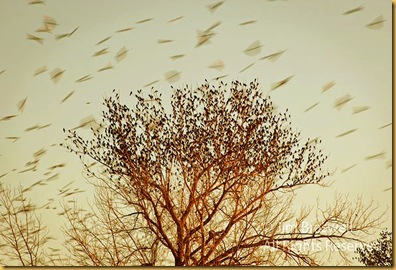
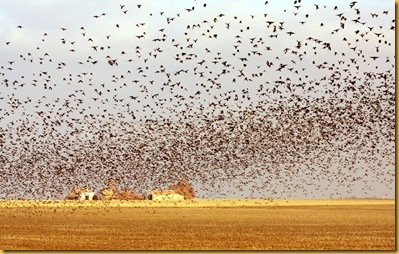
Putative truths, fanciful theories, not very credible inferences, and sundry episodes in this American's life


I came across the famous image above years ago when a worker in the university civil service system in charge of the huge serial collection in the University of Illinois Library’s main stacks. Astonished at the obvious prowess of the teamsters able to cart white pine logs like that from the original forests in Michigan, I remember how the photograph triggered a recurrent feeling, on the other hand, of sadness and longing to know the great American forest in its “original” state. This is a series of three posts that chronicles a road trip last month along Michigan’s “Circle Tour” route in search of a meaningful encounter with the state’s ancient forest of white pine. More poignantly, it’s an episode in a life-long quest to resolve that recurrent feeling typified by my reaction in the Book Stacks Office long ago.
There is often something special about long-lasting things that are “all original.” That intriguing quality is due to the things somehow escaping the human hand of alteration over their entire life span.
For example, the antique jelly cupboard in my dining room is all original. Made around 1880 out of poplar and pine, it’s never been stripped and refinished. It sports its original red paint with a rich patina deepened by over a century of oxidation. All its back dust boards are intact. Places where people pawed, including door latches and the areas surrounding them, are still darkened by years of handling. The square-cut nails and door hinges that fasten together its parts date to its origination in some kitchen cabinet maker’s shop. Such integrity promotes perpetuity and commands my admiration and respect.
When applied to nature, original usually means, “untrammeled” or wild. Such places keep their “natural” quality because they’re usually far away from our domesticating hands. They’re over there in the “wilderness.” Wilderness has always maintained an ambivalent status in the western world. Historically, it has been either attractive and enchanting, or repelling and loathsome. Environmentalists canonize its spiritual and ecological values, while moralists denigrate and warn against its pantheistic properties, and capitalists calculate its monetary and utilitarian potential. It either must be delivered with the zeal of a moral imperative or must be conquered and pillaged of its treasures with an equal zeal of a moral imperative. The battle over its status and its fate in the American landscape and in the American mind is legendary. And in my case it’s a personal one.
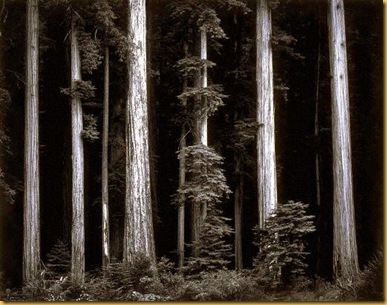 Ansel Adams Bull Creek Flat Redwoods ca. 1960
Ansel Adams Bull Creek Flat Redwoods ca. 1960
For me, wilderness has always been the ancient forest. I have marveled and mused about forests beginning with winter camping as a Boy Scout in the Laguna Mountains of San Diego County and backpacking in Sierra forests at the age of fourteen. I remember 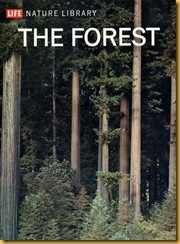 poring over a book I found in the library of First Colonial High School in Virginia Beach, part of the Life Nature Library series, entitled simply The Forest. Such intent pondering fed a growing resolve. I applied to the number one forestry school in the nation, State University of New York College of Forestry at Syracuse, but attended Oregon State University, starting as a forestry major, and ending with a degree in Botany. I have taught forests and the role of plants in the biosphere ever since as a high school science teacher, including having honors biology students collect longitudinal data along transects in two forest preserves for the Illinois Department of Natural Resources.
poring over a book I found in the library of First Colonial High School in Virginia Beach, part of the Life Nature Library series, entitled simply The Forest. Such intent pondering fed a growing resolve. I applied to the number one forestry school in the nation, State University of New York College of Forestry at Syracuse, but attended Oregon State University, starting as a forestry major, and ending with a degree in Botany. I have taught forests and the role of plants in the biosphere ever since as a high school science teacher, including having honors biology students collect longitudinal data along transects in two forest preserves for the Illinois Department of Natural Resources.
There has always been a tinge of tarnish to the quality of my experiences tromping through the woods, however. It’s because all forests are in someone’s ownership and control, even if that includes the public. And ownership begets alteration, subduction under the utilitarian hand of some form of management. We put our hands all over the things we own. It means, historically, that American forests were conquered and appropriated long ago, starting with the tall white pine in the north woods of New England for ship masts, proceeding to the great white pine belt of Michigan’s Lower Peninsula for building up Chicago, burnt to the ground in 1872, and ending with the grand Douglas fir forests of the Pacific Northwest for house framing and the coastal redwood in California for decking and grape stakes.
I have felt sadness and longing for the original, unaltered ancient forest on this continent all my life. It too once possessed an integrity and self-managing perpetuity that commands my admiration and respect. I’m a member of the generation that inspired Joni Mitchell to pen the Woodstock anthem that includes, “And we've got to get ourselves back to the garden.” The ancient forest is for me the Garden of ancient biblical verse. Modern psychology posits how we have an evolved cognitive ability to figure out how to turn its resources into benefits that fulfill our honest survival demands. Biblical myth posits how this knowledge also banished us from being an integral part of the garden because it contributed to our self-aggrandizing and secularizing power grabs leading to complete autonomy and lordship over all, symbolized by acquisition of power through eating from “the Tree of Knowledge.” But we’ve not forgotten its original state. Neural networks preserve an ancient memory of these kinds of places and nowadays spark a synaptic wistfulness to somehow see the wild places again and learn what they have to teach about the nature of ourselves and the world.
Seekers include Cincinnati artist friends of mine who trekked to the Black Forest of Germany for inspiration to depict what dark woods can do now to synaptic patterns in the brains of modern type folk who are long since divorced from them by the inexorable process of taming and civilizing the wilderness. Their project, called Maidens of the Cosmic Body Running, is a result of their explorations. “The maiden is one of many reoccurring characters throughout the work,” my friends write, “characters who are attempting to reach a primal and blissful state of being that evokes a sense of drama and mythology.”
Once a natural state, it must now be sought after. Providing the context and impetus to their searching for nature, literally a natural state, is the forest. In June of 2011, I saw their last big project, Majr Gazr, at the Contemporary Arts Center in downtown Cincinnati. It employed videos, futuristic geometric architecture, and various fiber-arts elements to invite me to become physically involved in a series of installations called “relaxion stations” as a metaphor for an inner psychological journey. I was made to exchange my shoes for a pair of wool felt slippers and ritualistically reconfigure myself, which included taking in a hypnotic video of a dark forest that was projected onto a set of curtains. My mental alteration would allow the Maidens to take control of my journey. The series of exhibits was an artistically mischievous, witchy, and ecstatic depiction of nature meant to show that, as a culture, we can’t easily define what nature is anymore. Manipulators, we have restructured nature for own purposes. The Maidens say this includes, for instance, romance. “Working in well-managed parks and planted forests, (the Maidens) exploit the artifice of those environments,” turning them, with a sense of mockery and defiance, into vehicles for romance. More than a literal representation of the wooded outdoors, forest images they used symbolize our psychic, complex self and how civilization has removed us from once spontaneous human intuition and impulse. Changing the forest physically changed the human changers psychologically.
Forestry got its start in Germany. The original hardwoods of the Black Forest are now mostly pine. Change began when the first German tribes fought the dark, howling wilderness, beating it back and away from their homesteads down to uprooting the stumps for farm fields. It was a moral imperative that they win this fight. The German terms wildnis and wildor signify wildness and wild game, respectively. The sources for our definition of terms having to do with the wild and alienating places and their contents are in Northern Europe, which was once heavily forested. Inhospitable “wilderness” thus had specific reference to the woods.
Much of the oral tradition of the forest dwellers preserved by the fairy tales of Brothers Grimm retain vestiges of the crusade to subdue and domesticate it and enduring lessons projecting from the enterprise. One outcome was a two-fold meaning, depending on one’s point of view, to the term wildnis. It could mean alien, mysterious, and threatening. It could also mean, on the other hand, beautiful, friendly, and capable of elevating and delighting the beholder.
Bruno Bettelheim, famous director of the Sonia Shankman Orthogenic School at the University of Chicago, where my daughter attended all of her high school, suggested in his book The Uses of Enchantment: The Meaning and Importance of Fairy Tales that these traditional stories, often set in the forest primeval, with the darkness of abandonment, death, witches, and injuries, allowed children to grapple with their fears in remote, symbolic terms. They are generally about the individual's responsibility to the community and specifically about parent’s responsibility for their children and the loving yet embattled interactions between them. Problems are often due to failure of community member’s duty, despite the best intentions. The witch character who figures so prominently isn't just a scowling old hag, but a key symbol of moral ambivalence. Primal forest set the tone for primal human instincts and behaviors.
European immigrants brought their instincts and behaviors to the fight for survival in America. The dark, sinister wilderness once again had to be conquered. They succeeded. Anymore, we must look hard to find wildness in the low places where rich soil stews in summer, where water slows as it finds its low point, and where warmer temperatures all combine to guarantee high enough productivity for humans. All such lands were long ago stripped of their original forest cover and taken over for farming. The grand expanses of the wilderness in the western regions of the United States are nice, but they’re mostly found high up in the mountains in the midst of bare rock and ice where productivity for human consumption would be reduced to a minimum because of the hostility of climate and terrain. Where is the wilderness of the low lands, the unplowed tall grass prairie in Illinois where I live, and the vast uncut swaths of white pine in Michigan?
19,000 acre expanse of Midewin National Tallgrass Prairie Park in NE Illinois, once an arsenal, now slowly being restored to its “orginal” state
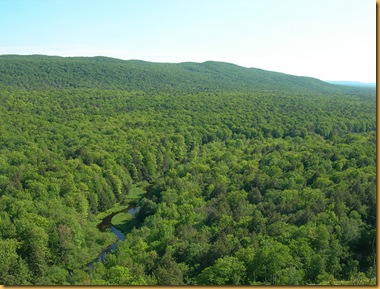 35,000 acre original forest, mostly hemlock that escaped logging, now in Porcupine Wilderness State Park in the UP; backpacked in 2004 and 2005; no similar tract containing white pine in either Michigan peninsula
35,000 acre original forest, mostly hemlock that escaped logging, now in Porcupine Wilderness State Park in the UP; backpacked in 2004 and 2005; no similar tract containing white pine in either Michigan peninsula
The story that describes the fate of the vast swaths of white pine in Michigan can be told in pictures. Serving as another kind of Grimm's fairy tale, telling it helps to resolve my conflict with inheriting a morally ambiguous and troublesome legacy involving wilderness.
The nation in the nineteenth century was made of wood. Railroads ran on beds of wooden ties and across wooden bridges. Homes, factories, schools, hospitals, churches, everything was made of wood. And so, of course, was furniture. The insatiable demand for it would be satisfied by Pinus strobus, the eastern white pine. Found in northern states from Maine to Minnesota, white pine grew tall and straight and knot free. It was light and floated well on log drives. It was soft and easy to cut in sawmills, yet strong, durable and resistant to decay.
 Early 1800’s New England drop-lid blanket chest; old lacquer on original red stain; dovetailed drawers; original hinges, lid lock
Early 1800’s New England drop-lid blanket chest; old lacquer on original red stain; dovetailed drawers; original hinges, lid lock
Who wouldn’t love the stuff? The wilderness of the Maine north woods for instance, supplied the big boards for a Connecticut River Valley blanket chest that’s in my living room, shown above. Quilts and blankets were a staple of New England winters, and I love the size of the box above its drawers, large enough to hold a family’s winter bedtime warmth in summer. It’s made entirely of eastern white pine.
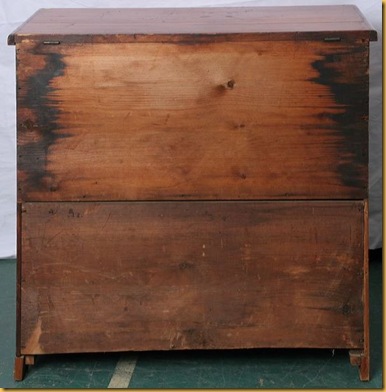 Dust boards on blanket chest back hand-planed white pine over 18 inches in diameter, cut from the center of the log
Dust boards on blanket chest back hand-planed white pine over 18 inches in diameter, cut from the center of the log
By 1840 it was apparent that the traditional sources of white pine in Maine and New York would be unable to supply a growing demand for lumber. Timber barons and saw mill owners cast their eyes to the white pine found in the mixed hardwoods of the northern half of Michigan’s Lower Peninsula.
Because of the initial lack of steam machinery, cutting the pine and moving the logs in the woods happened only in winter when wood wound down slippery snow trails drawn by draft horses on sleds. From 1840 to 1870, lumber companies set up logging camps near the rivers that filled with men from Maine, New York, Ohio, and Pennsylvania.
Seasonal camps consisted of log houses, including bunkhouses, cook shanty, barn, blacksmith shop, camp office and store, which typically included living quarters for the foreman and log scaler. Camps were shoddily built and abandoned once the trees were gone.
Though all ethnicities filled the camps, most of these “shanty boys” were of Irish and German descent. Scandinavians came later. Native-born workers outnumbered foreign-born by 1890 in two important lumbering counties, Muskegon and Manistee, by almost two to one.
Sunday saw boiling and drying sweaty clothes, and entertainment playing simple instruments and singing songs. The foreman forbade the use of liquor to eliminate fighting. The camp store sold tobacco.
Drying out was a constant of camp life. It was part of life centered around the pot bellied stove when in camp. Lumberjack identity was forged through stories told during the cold winter nights. From these stories came the tall tales about life in the north woods, Paul Bunyan.
Mattresses were stuffed with sawdust or feathery tips of coniferous branches. “Feeling lousy” meant being infected with body lice, one source of irritation in the camps.
Men were up by four for breakfast. Staples consisted of pancakes, salt pork, potatoes, bread with rose hip jelly to ward off scurvy, pie, and coffee. Staples were brought in by the barrel load. Eating off of china as opposed to tin was a scarce amenity much in demand.
The iconic axe of the “Paul Bunyan” lumberjack, as the primary tool in the woods, was short lived.
Cross cut saws quickly replaced old fashioned axes. Improvement in efficiency was too compelling for them not to. It’s interesting that the mythic character Paul Bunyan is never depicted with one. Is his ubiquitous ax a sign that saws contributed in part to a shameful demeaning of the noble labor of the lumberjack?
Saw crews cut the white pine into uniform length. Lumberjacks, most often single men in their twenties, worked from dawn to dusk six days a week, cutting, hauling, and piling logs. They were paid between $20 and $26 per month in addition to room and board. Those who stayed on in the spring as river drivers received higher wages due to the grueling nature and the very real dangers of their job.
Draft horses replaced oxen. Paul Bunyan never traded in his blue ox Babe for one, though. A sled, drawn by just a pair of them, could haul 15 tons of logs. Contests were held between rival camps to see which could stack a load the highest. Most loads, despite the economic incentive to maximize yield, were less due to the risks.
Simple machines, including levers, inclined planes, wheels and pulleys, plus horse power, took millions of logs from the pine lands.
A special crew set up and maintained the trails from woods to river. Special water sprinkler wagons ensured icy, and thus more slippery, sled tracks to enable the horses to haul the heavy loads. To avoid skidding on the down-hill, potentially disastrous to the invaluable horses in front of the loads, they dusted the trails with wood chips.
Before steam engines and railroads made it to Michigan, wood could only move by water. The state, crisscrossed by a network of rivers large enough to float logs, such as the Saginaw and Muskegon, provided convenient transportation to sawmills and lake ports. Logs were piled thirty feet high in winter, awaiting the spring thaw.
The river drive was dependent on a good winter snowfall to provide a spring run-off that enabled the rivers to carry huge logs to the sawmills.
Logs having reached the river mouths piled up in the harbors.
Associations were formed to cooperate in the sorting of logs into a pond or bay where floating "booms" of logs separated the property of one company from that of another.
A log mark (the logging equivalent of a “cattle brand”), stamped onto the ends of logs with a marking hammer, determined ownership.
The first sawmills were logically located at the mouths of the driving rivers. Like the men in the woods, mill hands worked long hours. They did not face the isolation of the logging camps, but their working and living conditions were often worse: noisy, dirty mills and dingy, cramped housing. Although mill workers received higher wages than loggers, from $30 to $50 per month, they had to provide their own room and board. They were also more likely to have families to support in contrast to the “shanty boy” (implying single) loggers.
Much of the downed timber was rafted to sawmills in other cities along the Great Lakes once ship technology grew powerful enough.
The sawmill was the first unit of the lumber industry to achieve increased output through technological improvements. Although water-powered mills were still common in the 1860’s, steam saws, whether up-and-down or circular, were rapidly replacing them. Steam saws so increased the capacity of the mills that it became necessary to devise faster methods of handling both logs and sawn lumber in order to avoid pile-ups and delays.
Other innovations reduced waste. The first circular saws of the 1860’s had wide blades that produced mountains of sawdust. They wobbled as they cut, so that boards more nearly resembled washboards than lumber. Within a few years, however, these problems had been solved. The widespread adoption of the band saw in the 1880’s further reduced waste. Metal technology now made it possible to build a saw with a thin band of steel operating as a continuous belt that cut both rapidly and efficiently.
By 1869 Michigan was producing more lumber than any other state, a distinction it continued to hold for thirty years. Many of Michigan’s cities---Saginaw, Bay City, Alpena, Cheboygan, Onekema, Traverse City, Manistee, Ludington, Muskegon and Grand Haven, began as sites for lumber mills.
A Michigan-initiated innovation during the 1870’s was responsible for a large increase in logging production. The Big Wheel, invented by Silas Overpack of Manistee, enabled cutting to continue in the snowless seasons by providing an alternative to sled transportation. Logs were chained beneath the axle and dragged. Once the inertia of the load had been overcome, it was relatively easy to keep the wheels moving.
This is a logging camp in summer; with the invention of the Big Wheel, the seasonal winter camps could proceed, instead, year round.
By the 1870’s steam power came to the north woods in the form of the Shay locomotive.
Steam power also increased the efficiency of lifting and loading logs.
Like the logging wheels, the narrow gauge rail helped to make lumbermen independent of the weather. Trains could be used in place of sleds year round for the relatively short run to the riverside banking grounds, or the river drive itself could be ended by carrying the logs to a mainline railroad depot. In addition, the logging railroad was sufficiently economical to allow cutting in areas once considered too far from the nearest driving stream to make sledding practical.
Shay locomotive on narrow gauge rail in summer
Interlude: Timbermen and Technology
The era of Michigan lumbering occurred during major improvements in technology during the height of the industrial revolution. Technological inventions that netted greater efficiency and thus a faster demise of the white pine forests, vividly shown in these pictures, had a huge impact on the lumberjacks. One source for understanding this impact is their oral traditions that come down to us in the form of stories told by the shanty boys. Storytelling served not only as entertainment during long and cold winter nights in the shanties, but affirmations of pride and effective means of encouragement. Stories recounted their brute strength, hands-on skills, prowess, and daring in the woods. They help to provide insight into the demise of the tall timber, the self image of those responsible, and the impression that technological improvements had on them.
An important background to our understanding that impression is the observations of the Frenchman Alex De Tocqueville who visited in the 1830’s and later wrote his conclusions about American manners and attitudes in his important work, Democracy in America. He was the first to state how Americans didn’t notice the wilderness; rather their “march across these wilds, draining swamps, turning the course of rivers,” and reducing the forests to lumber and the lands they once covered to farms. The American worker improved himself at the expense of the wilderness, which merely served as an occasion for the project. Pride in conquest was earned by means of old world technology he was familiar with, hand-held and ox-drawn plow, ax and shovel, sail schooner, water powered mills, all using simple machines, wheels, levers, screws, pulleys, and inclined planes.
The American attitude behind the ever expanding empire that De Tocqueville described on his travels across America was responsible for generating and celebrating mythological heroes who symbolized moral development and improvement in character through work. These heroic role models grew ever more fantastic in the imagination of the oral traditions because they had the important functions of myth, to help justify the intentions of the people and explain the origins of this intent and its consequences. In the north woods, the mythological hero par excellence was Paul Bunyan.
I vividly recall a Disney cartoon I saw on the 7 pm Sunday evening show Disney Presents entitled simply Paul Bunyan. Cartoon Paul “63 ax handles tall” sent trees flying like toothpicks with his double-bladed ax and stacked logs a mile high with the help of his ox companion Babe. Thanks to You Tube, I get to see this story again 54 years later.
Walt Disney Presents Paul Bunyan, Part 1
Walt Disney Presents Paul Bunyan, Part 2
Tall Paul by his actions legitimated the past and held out promises for the future when audiences heeded his model of self-improvement. Thus Paul served as an archetypical object lesson in a deeply imbedded tradition motivating Americans in the nineteenth century, the so-called Protestant Work Ethic. Formulated by Max Weber, the tradition received its impetus from Calvinism that posited man’s moral depravity, his sin, and his need for deliverance from it. Triumph over sin was, of course, the fitting sacrifice for its expiation by God himself through a deliberate act of death on the cross. But who would benefit was complicated by the tradition of predestination, that the fate of every individual regarding heaven or hell had been decided since the beginning. And no one could know for sure if they were amongst the so-called “elect.” According to Weber, Protestants who were successful producing wealth could look to that success as a sign of election. And the manner that would generate wealth was hard work and upstanding character… such as that of Paul Bunyan.
The cartoon depicts Paul as clean cut, despite a five o’clock shadow, simple, upstanding, and confident in the work he performs.
With my double-bladed ax and my caulk-nailed boots
I follow timber’s call
When there’s work to be done there’s no mess’n around
Just sing right out for Paul
Hey Paul! Hey Paul! Paul Bunyan!
I’m comin’, boys!
He’s sixty three ax handles high
With his feet on the ground
And his head in the sky
Hey Paul! Hey Paul! Paul Bunyan!
Bunyan takes no notice of the felled wood. Cartoon logs are as light as pretzels, and they sprinkle like sugar. It’s just what he does. What matters is the act of doing it, which is driven by personal responsibility and a clean conscience. These moral improvements lead to success and wealth, signs of election. His life style isn’t shown as upwardly mobile over the course of his indiscriminate chopping away, which is consistent with the work ethic’s tenet that wealth gained through work isn’t for spending; rather for accumulating as a sign of God’s elect.
Paul is God’s surrogate, responsible for acts of creation, such as the 10,000 lakes of Minnesota by his stomping around, and the Tetons made out of flat ground kicked up when he and his ox playfully wrestle.
The narrator states, “Before long the sawmills had enough timber to last a lifetime. And that opened up plenty of new farmland.” This gave further justification to the moral incentive to accumulate timber wealth as a sign of election because cutting down all the trees benefitted the farmer. From blade to plow, the heavenly work just goes on.
There is moral ambivalence on the part of this big player Paul, however. With the timber of wilderness converted into towns of civilization, Paul finds himself crowded. He resolves the conflict by moving to new timber. He serves as a tool of legitimacy for the perpetual razing of the forests because it causes civilization to expand. Again the object is himself who serves as a surrogate for everyone working in the woods toward which he and they are indifferent, an attitude that appears consistent throughout the cartoon.
Disney depicts how Paul’s work extends civilization all the way to the West Coast. “Civilization had arrived in the great Northwest,” the narrator explains. Ships are shown entering San Francisco Bay bringing immigrants who need wooden houses. Paul logging in the Pacific Northwest is providing them with that timber.

Then something ominous and foreboding happens. A character named Joe Muffaw demonstrates the new invention of the steam-powered chain saw for felling timber. Paul is appalled, indignant at this affront to the muscle power and skill of the lumberjack. His reaction leads to confrontation. The resolution is a contest to see which method, ax or steam power, is most productive. They each in an hour attempt to cut more than the other, piling up their logs in a measurable heap.
My memory of this episode is so strikingly vivid because I, as an impressionable 8 year old, was appalled at the mindless mowing down of trees depicted in this pursuit of triumph and glory. Muffaw won by a quarter of an inch. I notice that this victor is portrayed as a wily, pompous, conniving little weasel of a man that is obviously meant to vilify him. Outmoded and thus outdated, vanquished Paul sadly exiles himself to Alaska where there’s still plenty of room and where his cavorting with Babe in it causes the Northern Lights.
The advent of steam power and its rapid hegemony over horse, brute labor, and skills using hand-wielded simple machines thus had to have greatly affected the lumberjack, as the story of Paul Bunyan attests. Positive impacts on the efficiency of getting the logs to market caused negative impacts on the lumberjack’s self image as a forest laborer and the prospects of his continued employment in the woods. Isn’t this always the result of new technology turning skills into obsolescence and proud workers into displaced employees?
This cartoon may not have turned me into a labor activist, but it may singlehandedly have turned me at the age of 8 into a wilderness purist.
PEAK LUMBER PRODUCTION BY RIVER VALLEY
In 1889, the year of greatest lumber production, Michigan produced 5.5 billion board feet, meaning wood a foot square and an inch thick.
In their haste to move on to new sites, lumber companies usually gave little thought to the lands they were leaving. By the 1870s stumps and branches already littered much of northern Michigan. There was no longer any barrier to erosion on cutover land, and the dried debris created an enormous fire hazard. At the end of the dry summer months, fires frequently broke out, sometimes moving into still uncut timberlands or settled areas, as in 1871 and 1881, when fires broke out across the state. Some were so hot that the accumulated seed bank that could spawn the next generation and all remaining soil nutrients were roasted into oblivion. A century later, stumps stand like ghosts of forests past, the land unable to regenerate anything.
Lumber companies had no desire to retain logged over land, and thus they tried to sell large tracts of it in the 1880’s and 90’s. They vigorously promoted the former forests as good farmland, ready for the plow, but experience soon proved that this was not the case. Found 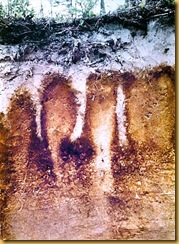 only in Michigan and designated the official state soil in 1990, Kalkaska sand is little more than a thin layer of gray sand atop a thick layer of brown and yellow sand left behind by the glaciers. Pine needles do not easily break down into humus and lie undecayed on the forest floor. So humus does not build up a rich organic bank of fertility. Similar to tropical forests, the fertility of the land is locked up in its forest cover and thus leaves with the trees. Moreover, since sand is highly permeable to water, which leaches away nutrients when it goes, there is little moisture and nutrients available for crops. 750,000 acres in the heart of the cut over pine belt having this soil simply could not support continuous farming. Families that had put all their savings and hopes into such a farm often had no alternative but to give it up when they could not pay their taxes. The State of Michigan ended up acquiring tax delinquent land as well as acreage simply abandoned by lumber companies. A glance at the map shows one of the largest land holdings of state forest of any state in the U.S.
only in Michigan and designated the official state soil in 1990, Kalkaska sand is little more than a thin layer of gray sand atop a thick layer of brown and yellow sand left behind by the glaciers. Pine needles do not easily break down into humus and lie undecayed on the forest floor. So humus does not build up a rich organic bank of fertility. Similar to tropical forests, the fertility of the land is locked up in its forest cover and thus leaves with the trees. Moreover, since sand is highly permeable to water, which leaches away nutrients when it goes, there is little moisture and nutrients available for crops. 750,000 acres in the heart of the cut over pine belt having this soil simply could not support continuous farming. Families that had put all their savings and hopes into such a farm often had no alternative but to give it up when they could not pay their taxes. The State of Michigan ended up acquiring tax delinquent land as well as acreage simply abandoned by lumber companies. A glance at the map shows one of the largest land holdings of state forest of any state in the U.S.
By 1920, the pine exhausted and the forest left in squalor, the great era of Michigan’s original white pine forest came to an end. Get rich timber mining, politically legitimated by the desires of a growing nation, had extracted 162 billion board feet of the wood from the Michigan wilderness in just 80 years. After the big cut, the abandoned land burned again and again in gargantuan fires millions of acres in size. History is rich in lessons gained from investigating empires when they decline and fall. The irony of the timber empire and its demise when the white pine ran out is that the Michigan timber barons went on to invest their capital in the next empire, that of the automobile.

| Earn a degree at the online degree website. |